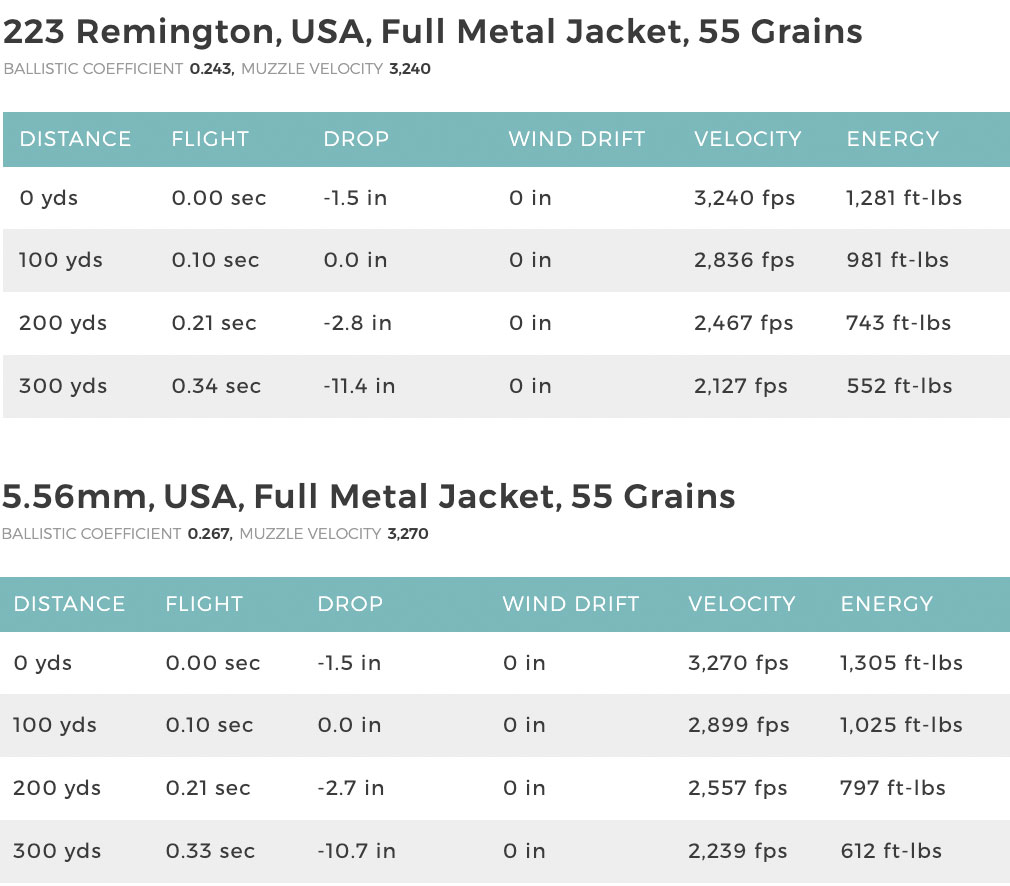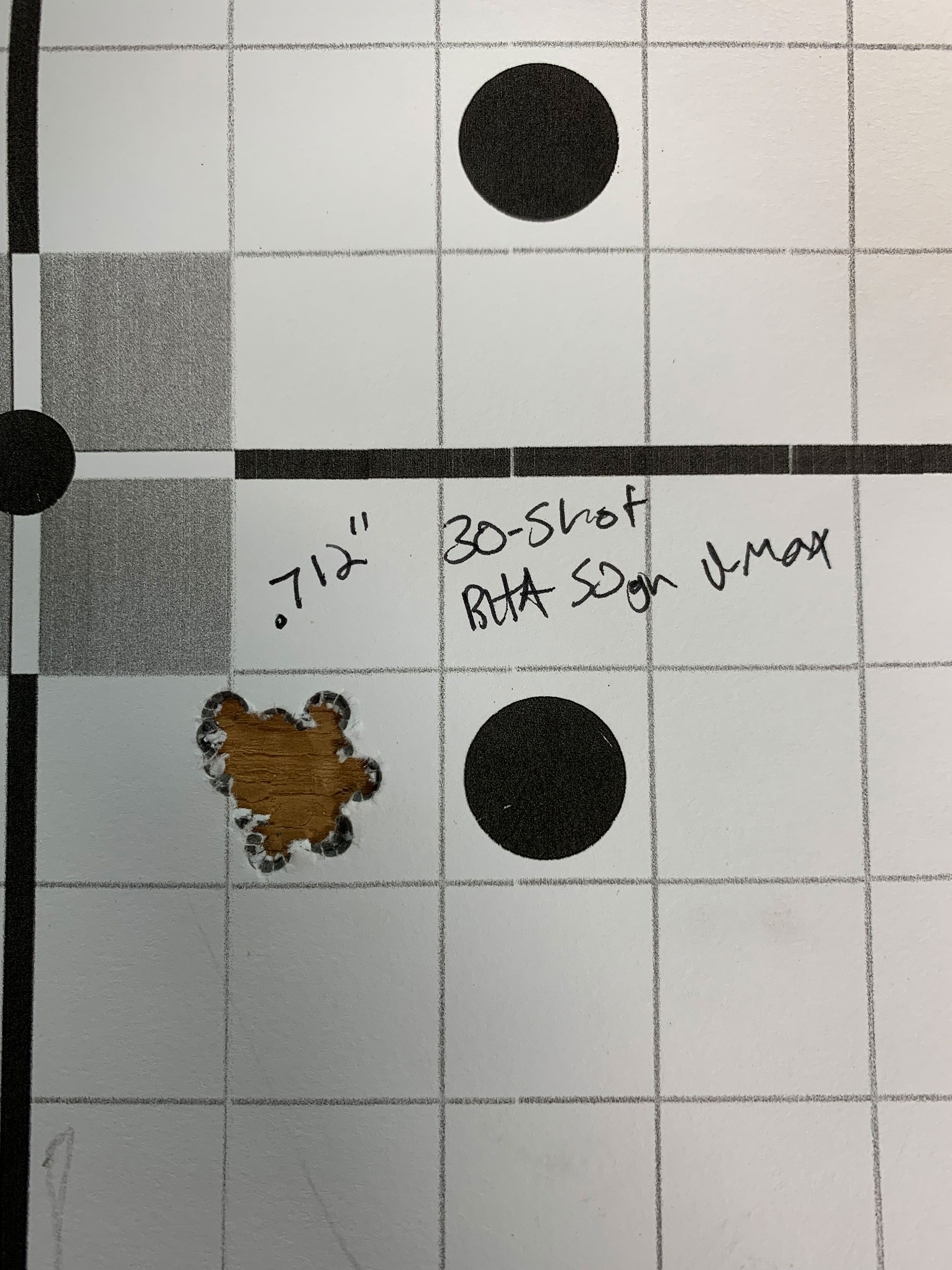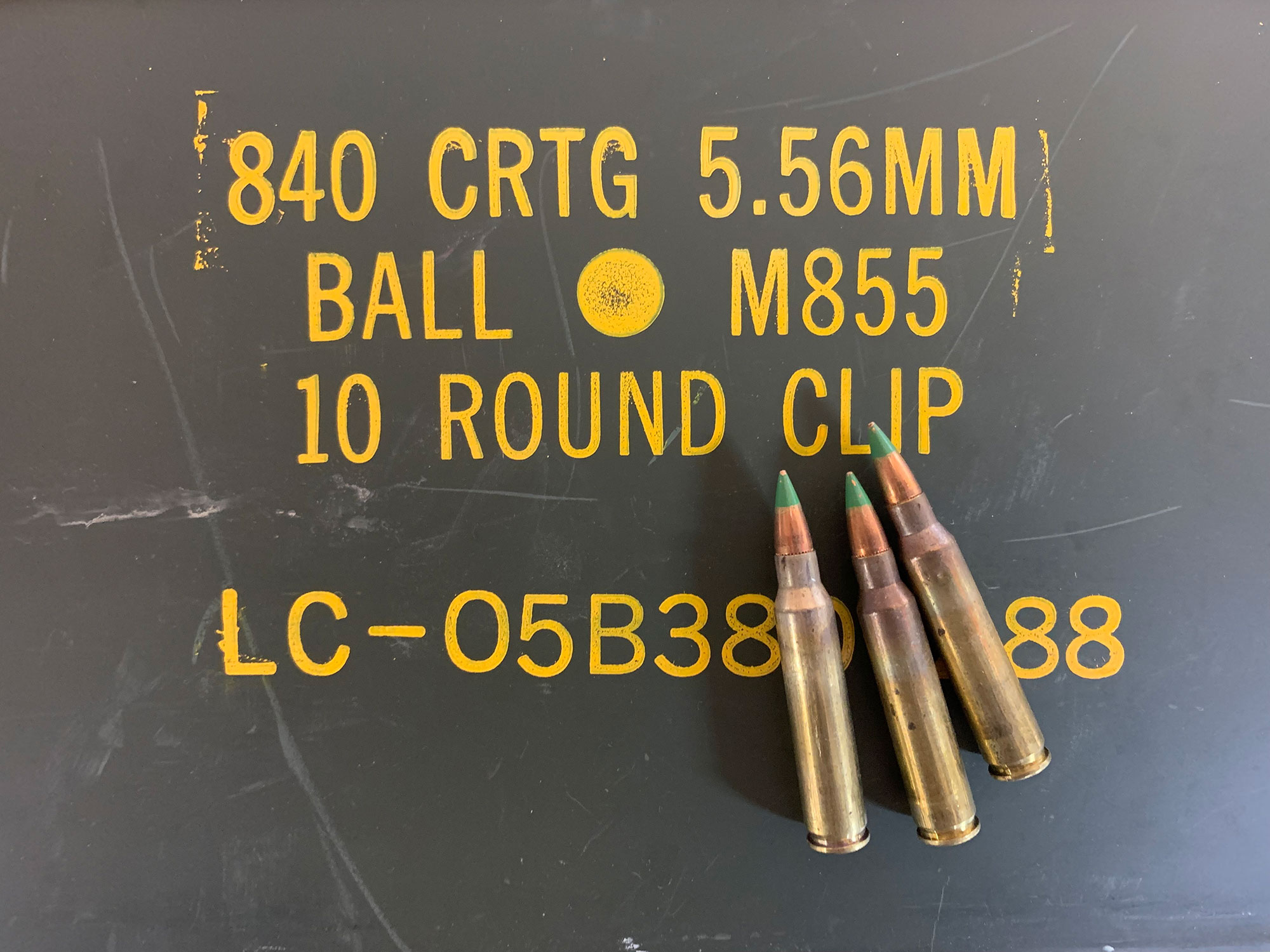We may earn revenue from the products available on this page and participate in affiliate programs. Learn More ›
Despite the abundant similarities and identical external case dimensions of the .223 Remington and 5.56x45mm NATO cartridges, a deep dive into the two exposes some minor, yet crucial differences. Since their inception, these two cartridges have become some of the most popular centerfire cartridges of all-time with widespread applications.
Even with the popularity of these two cartridges, there are still many common misunderstandings and questions about their differences. Primarily, is 5.56 NATO and .223 Remington ammunition interchangeable? The answer is both yes and no. Put most simply, .223 Rem. ammunition can safely be fired out of rifles chambered in 5.56 NATO, but the same cannot be said when firing 5.56 NATO ammunition in a .223 chamber.
At least that is what we are told. Due to the increase in chamber pressure when firing 5.56 NATO ammunition, paired with the slightly shorter throat in .223 chambered rifles, shooters are warned that 5.56 NATO ammunition should not be fired in rifles chambered in .223 Rem. The two share nearly identical case dimensions and fire the same bullets, allowing shooters to easily chamber ammunition with both cartridges but just because you can doesn’t mean you should. Here’s what you need to know about the 5.56 vs .223.
.223 Remington Specs
- Bullet Diameter: 0.224 inches
- Case Length: 1.76 inches
- Overall Length: 2.26 inches
- Parent Case: .222 Remington
- Case Capacity: 28.8 grains H2O
- SAAMI Chamber Pressure: 55,000 psi
5.56x45mm NATO Specs
- Bullet Diameter: 0.224 inches
- Case Length: 1.76 inches
- Overall Length: 2.26 inches
- Parent Case: .223 Remington
- Case Capacity: 28.5 grains H2O
- SAAMI Chamber Pressure: 61,000 psi
History
Remington Arms officially submitted the .223 Remington cartridge design to SAAMI in 1962 after several years of research and development in conjunction with the U.S. Continental Army Command, Fairchild Industries, and Eugene Stoner of Armalite. The work with Stoner was significant due to his primary role in the invention and implementation of the AR-10 platform. Their shared goal was to create a lightweight cartridge and rifle combination that provided acceptable terminal ballistics at extended distances on a more nimble platform compared to the AR-10 chambered in 7.62x51mm NATO.
The end result was the launch of Armalite’s AR-15 rifle, chambered in .223 Remington, propelling a 55-grain bullet at 3,250 fps. Two years after its submission to SAAMI, the U.S. Army adopted Armalite’s AR-15 rifle, dubbed the M16. The M16 first saw combat in the Vietnam war and went on to become the standard military issued service rifle in 1969. Since then, the .223 Remington cartridge has expanded to nearly every shooting endeavor from hunting to competitive shooting and everything in between. The success of the .223 Remington also expands beyond its AR-15 roots and it is commonly chambered in a wide variety of rifle configurations.
Following the success of the .223 Rem., NATO signed an agreement in 1977 to begin the selection process of replacing the 7.62x51mm NATO cartridge. FN Herstal answered the call, developing the 5.56 NATO cartridge, which only slightly differentiated itself from the .223 Rem. That difference between the two cartridges came in the form of thicker walled brass which created a slightly smaller case capacity for the 5.56 NATO cartridge. The slightly thicker walls and smaller case capacity allowed the 5.56 NATO to handle the increase in pressure from heavier charge weights, hence the popular warning that 5.56 NATO ammunition should not be fired in rifles chambered in .223 Rem.
For comparison, the 5.56 NATO has a maximum of 61,000 PSI of chamber pressure while the SAAMI approved chamber pressure for the .223 Rem. is 55,000 PSI.
By late 1980, NATO officially adopted and standardized the 5.56 NATO cartridge. Fast forward 40 years and the 5.56 NATO continues to be one of, if not the most, used cartridge amongst military forces worldwide. That fact alone speaks volumes to the validity and effectiveness of the cartridge.
The .223 Wylde
Lots of 5.56 NATO ammunition is commercially available, and as a universal solution to the discrepancy between 5.56 and .223 chambers, several rifle manufacturers began chambering rifles in .223 Wylde, which was developed by Bill Wylde. The Wylde slightly altered the chamber dimensions to accommodate the pressures created by both 5.56 NATO and .223 Rem. ammunition. Also, despite the warnings, many shooters freely shoot 5.56 NATO ammunition out of their .223 Rem. chambered rifles without issue. OL Staff Writer, Tyler Freel, discusses this in his extensive review of the best 5.56 ammo and .223 ammo test. If you want to fire 5.56 NATO ammo through your .223 chamber, proceed carefully and watch for any excessive pressure signs. If you’re buying a new gun or barrel, you can eliminate any potential ammo and pressure issues by purchasing a .223 Wylde or 5.56 NATO.
Ballistics
Comparing ballistics between the 5.56 vs .223 reveals only small differences. To compare apples to apples, I selected two factory loads from Winchester, both of which are loaded with a 55-grain FMJ projectile.

Winchester 223 Rem. 55-grain FMJ
- Muzzle Velocity: 3240 fps
- Energy @ 300 yards: 552 ft-lbs.
- Drop @ 300 yards: 11.4 inches (with 100-yard zero)
Winchester 5.56 NATO 55-grain FMJ
- Muzzle Velocity: 3270 fps
- Energy @ 300 yards: 612 ft-lbs.
- Drop @ 300 yards: 10.7 inches (with 100-yard zero)
However, muzzle velocity and downrange energy will vary depending on your bullet selection. Projectile weights vary from 35 grains on up to 85 grains with 55- to- 62-grain bullets being the most popular. For comparison, I selected ammunition loaded with light, mid-weight, and heavy bullets to highlight differences in ballistics and the versatility of the two cartridges.
Hornady 223 Rem. 35-grain NTX Superformance
- Muzzle Velocity: 4,000 fps
- Energy @ 300 yards: 411 ft-lbs.
- Drop @ 300 yards: 5.3 inches (with 200-yard zero)
Nosler 223 Rem. 55-grain Ballistic Tip Varmint Ammunition
- Muzzle Velocity: 3,100 fps
- Energy @ 300 yards: 533 ft-lbs.
- Drop @ 300 yards: 7.7 inches (with 200-yard zero)
Barnes 5.56 NATO 85-grain Precision Match
- Muzzle Velocity: 2,600 fps
- Energy @ 300 yards: 745 ft-lbs.
- Drop @ 300 yards: 11.5 inches (with 200-yard zero)
These three ammunition offerings paint a valuable picture for understanding the differences in muzzle velocity and downrange energy that is obtainable with the .223 Rem. and 5.56 NATO cartridges.
Recoil
Recoil, or the lack thereof, from these two cartridges is one of their biggest selling points and tremendously aids their popularity. The vast majority of 5.56×45 ammunition produces between 5 and 6 ft-lbs. of recoil. In simple terms, the recoil produced from these two cartridges is negligible. This allows shooters to stay on target, watch bullet impact and make quick follow-up shots if necessary.
Accuracy

Both the .223 Rem. and the 5.56 NATO are capable of delivering exceptional accuracy. With that said, accuracy with these two cartridges can and will vary depending upon your rifle and ammunition selection. One variable to always consider when selecting ammunition is your barrel twist rate. Most .223 Rem. and 5.56 NATO rifles sport 1:7 or 1:8 barrel twist rates, which are ideally situated for stabilizing and shooting everything from 50- to- 75-grain projectiles accurately. If you struggle to get lighter or heavier bullets to group consistently, there is a high likelihood it has to do with your barrel’s twist rate and not the ammunition.
Use our test of .223 Rem. and 5.56 NATO ammunition as a baseline when looking for the best ammunition for these two cartridges.
Terminal Performance
When it comes to evaluating the 5.56 vs .223, both pack plenty punch to deliver adequate terminal performance in a variety of hunting pursuits. However, given the small diameter and bullet weights, hunters must be conscious of the cartridge’s limitations in hunting scenarios. With a well-constructed bullet, such as Hornady’s 50-grain monolithic CX bullet or Nosler’s 70-grain Accubond, hunters can confidently take down deer-sized game at reasonable ranges with the .223 Rem. and 5.56 NATO. Shot placement is key, especially when shooting small projectiles. These cartridge and bullet combinations are ideal for recoil shy and first-time hunters.
While the .223 Rem. and 5.56 NATO are plenty capable in the deer woods, they really shine in the varmint hunting world. Unlike the bullets necessary for taking down a deer, the majority of varmint hunting projectiles are designed to penetrate the thin skin of a coyote or fox and inflict massive amounts of internal trauma. The result is dead-on-impact hits that rarely require a tracking job.
Ammunition Availability and Selection

Ammunition availability for the .223 Rem. and 5.56 NATO has been hit and miss over the past several years, but now manufacturers produce copious amounts of ammunition for these two cartridges. At least at the moment, 5.56 and .223 ammo is readily available both online and in most sporting goods stores.
The cost of .223 Rem. and 5.56 NATO ammunition varies depending on your intended use. If you are just looking to plink steel at the range, cheap M193 full metal jacket ammunition can be purchased for as little as $13.00 per box of 20. On the flip side, ammunition loaded with premium hunting and match bullets can run upward of $60.00 per box of 20.
Unlike many other cartridges, 5.56 and .223 ammo is often available in bulk. Most major ammunition companies package 5.56 ammo that can be purchased in case quantities of 200, 500, or 1,000 rounds. Buying in bulk typically saves you money in the long run.
Read Next: Coyote Cartridges: .223 Rem. Vs. .22-250 Rem. Vs. .243 Win.
Final Thoughts on the 5.56 vs .223
While the .223 Rem and 5.56 Nato are similar, it is important for gun owners to educate themselves on the nuances of both cartridges and at least be aware of the difference in chamber pressures between the two. If you choose to shoot 5.56 NATO ammunition through a .223 Rem. chambered rifle, you must vigilantly watch for any and all signs of excess pressure. Regardless of your shooting pursuits, everyone should own a rifle chambered in one (or both) of these cartridges. They are practical and capable of everything from hunting to personal defense. Plus, they are downright fun to shoot.
